Types of Gourds With Pictures and Identification Chart
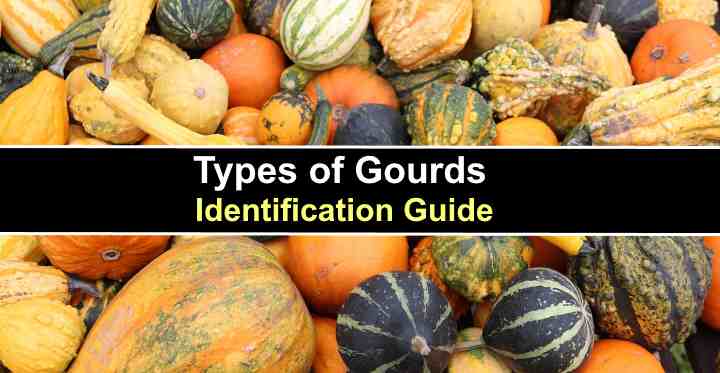
Gourds are a diverse group of plants recognized by their thick, tough skin, large size, and unusual shapes. Some types of edible gourds are instantly recognizable—think pumpkin, butternut squash, and cucumbers. Other types of ornamental gourds have decorative or practical value. People use them to make birdhouses, water jars, and a variety of crafts.
From decorative purposes to culinary delights, exploring the various types of gourds can be an intriguing journey. Gourds have had a place in civilization for thousands of years. They come in a vast array of shapes, sizes, colors, and textures, each with distinctive characteristics. Some gourds are large round fruits with smooth skins. In contrast, others are small and warty with unusual shapes.
This article explores the fascinating world of gourds, their types, and their remarkable qualities. You will learn about cultivating and harvesting gourds and how to use them for their aesthetic appeal.
What is Gourd
A gourd is a fruit—botanically a berry—of a flowering plant in the family Cucurbitaceae. The fruits have a tough, sometimes hard outer skin surrounding firm flesh. Most types of gourds belong to the species Lagenaria and Cucurbita. Gourds include fruits like bottle gourds, pumpkins, luffas, melons, squash, and cucumbers.
Types of Gourds (with Pictures)
Even though all gourds are part of the Cucurbitaceae family, we group them based on how we use them. Some gourds aren’t meant for eating; instead, we use them to make things like utensils, or we value them for how they look or their practical uses. But there are also gourds that are great for cooking – we can bake, fry, or cure them for yummy dishes
Bottle Gourds

Bottle gourds are hard-shelled gourds of the species Lagenaria siceraria. The fruits grow in various shapes on the calabash vine—from huge and rounded to small and bottle-like. Young bottle gourds have edible, white flesh. Mature bottle gourds develop hard skin and are usually left to dry naturally.
Types of bottle gourds include dipper gourds, speckled swan gourds, powderhorn gourds, and dinosaur gourds.
Uses of bottle gourds include drinking or storage containers, musical instruments, birdhouses, and hats.
Rounded bottle gourds are often called calabash gourds. Other names for bottle gourds include long melon, white-flowered gourd, opo squash, birdhouse gourd, and Tasmania bean.
Ornamental Gourds
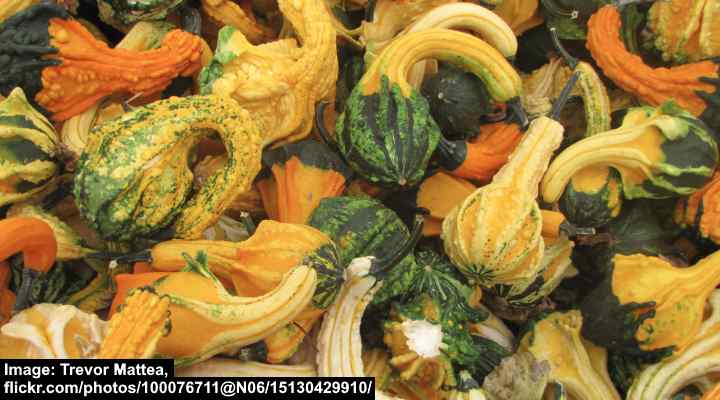
Ornamental gourds are typically from the species Cucurbita. These types of gourds are renowned for their exceptional decorative features. Native to America, the red, yellow, and orange gourds have an extensive range of shapes and textures. Some are smooth, velvety, or shiny. In comparison, others are bumpy and covered in warts or ridges.
Among ornamental gourds, Cucurbita pepo varieties stand out with their charming and vibrant ornamental gourds. With their delightful colors and bumpy appearance, these small gourds are perfect for adorning any space, adding beauty and elegance to any décor. They are egg-shaped, pear-shaped, and warty gourds.
Sponge Gourds (Luffa Gourds)

Sponge gourds—or luffas—are some of the most unusual gourd fruits. Luffa aegyptiaca and Luffa cylindrica are commonly known as the bath sponge. Surprisingly related to cucumbers, the vining fruit is harvested and dried. Its outer shell is removed, revealing a scratchy inner fiber perfect for use as an exfoliating sponge.
Other names for natural sponge gourds include rag gourd, dishrag gourd, vegetable sponge, and smooth luffa. The type of gourd with a rougher fibrous inside is Luffa acutangula, or ribbed luffa. The fruit’s dried fiber can also be used to make hats.
Snake Gourds

Snake gourds are weird fruits in the family Cucurbitaceae. They are identified by their long, winding shape, resembling a snake. When young, the flesh is edible without any distinctive flavor. However, snake gourds develop a hard shell once fully matured and can be used as musical instruments.
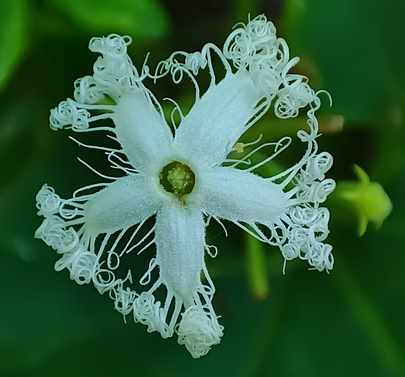
Snake gourd flower
One of the most fascinating aspects of the snake gourd is its nocturnal flowers. The strongly scented white flowers bloom at night and are pollinated by moths. Its seeds are like watermelon seeds. This long and winding fruit is an eccentric member of the pumpkin family, adding stunning visual elements to garden landscapes.
Edible Gourds

Edible gourds include a wide array of versatile fruits commonly used in cooking. Varieties include zucchini, acorn squash, pumpkins, and butternut squash. The delicious, nutty fruits have tremendous culinary appeal in many cuisines. You can roast, bake, or sauté them or incorporate them into soups, stews, and pies.
Gourd Vine Flowers

Examples of gourd vine flowers
Gourd vines bloom with large white or yellow flowers that typically open at night. Some varieties of gourd vines have large five-petalled blossoms in a star shape. Others have edible yellow, cup, or urn-shaped flowers. These vibrant flowers have bright colors and scents, enhancing garden aesthetics and attracting pollinators to landscapes.
Gourd vs. Pumpkin
Gourds and pumpkins both belong to the Cucurbitaceae family. Typically, the term gourd refers to fruits with hard shells, typically used in crafts and decoration. Pumpkin usually refers to softer and edible fruits used in many culinary applications and decorate homes at Halloween.
So, while all pumpkins are a type of gourd and can be edible or ornamental, not all gourds are pumpkins.
Gourd vs. Squash
The distinction between squash and gourds mirrors that of pumpkins. Generally, squash are fruits known for their edible or ornamental qualities, characterized by softer skins. Compared to pumpkins and gourds, squash fruits often have a shorter shelf life due to their thinner skins. As a result, popular varieties like acorn squash and butternut squash are frequently pickled or canned to prolong their usability.
Varieties of Gourds (with Pictures) – Identification Guide
Let’s look in more detail at how to identify different varieties of gourds. Descriptions and pictures of various types of gourds, including ornamental, sponge, bottle, and edible gourds, will help you recognize and choose the best gourd plants for your garden.
Bottle Gourd (Lagenaria siceraria)
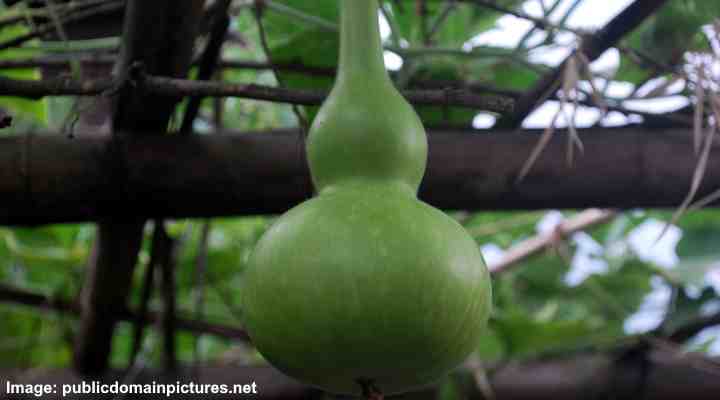
Bottle gourd is a type of vine fruit that usually has hard skin when mature. These varieties include a range of gourds with various common names. Bottle gourds can be slim, snake-like, large, round, pear-shaped, and bottle-shaped. Also called calabash gourd, most varieties are left to mature and dried to be used in various crafts.
Fast-growing bottle gourd vines can grow up to 30 ft. (9 m long) in a season. They can spread on trellises or climb a pole or sturdy fence. However, due to the weight of the large fruits, the vines need solid support. The vines bloom at night with attractive white flowers that emit strong scents.
Bottle gourds are sometimes harvested when young. The immature “berries” have a mild, crisp flesh and are suitable for inclusion in various dishes. Bottle gourd flesh goes well with meat, seafood, and soups. A gourd variety called zucca da vino (Lagenaria siceraria var. longissima) is used in Italian cuisine in pasta dishes.
Dipper Gourd (Lagenaria siceraria)

The dipper gourd is a bottle gourd variety with an elongated, narrow neck and bulbous base resembling a ladle or dipper. The bulb-like base can measure up to 10” (25 cm) in diameter, and its long, slender neck or handle can measure 12” (30 cm) or more. The fast-growing vining fruits take 120 days to mature.
Dipper gourd fruits are prized for their practical and decorative purposes. It is green when growing and turns sandy tan shades when mature. The hard fruits are popular for crafting into ladles or large spoons. Also, its distinctive shape adds aesthetic appeal to gardens.
Extra Long Handle Dipper Gourd (Lagenaria siceraria)
The extra-long handle dipper gourd is renowned for its spectacular elongated, narrow neck and a spherical, globular base. The beautiful vine fruit produces green gourds with necks or handles measuring 2 to 4 ft. (0.6 – 1.2 m) long.
To grow straight-necked gourds, growing the vine on a tall trellis is vital to allow the bottle gourds to hang vertically. Like the shorter dipper gourd, the long-handled variety is popular for crafting traditional large ladles and spoons.
Dinosaur Gourd (Lagenaria siceraria)

The dinosaur gourd is a unique type of bottle gourd, identified by its deeply textured skin resembling reptile scales. The gourd plant has lustrous, deep green, wrinkled skin, and an elongated pear shape. The bulbous base measures 8” (20 cm), and its long neck is 18” to 24” (45 – 60 cm) long.
Also called the caveman’s club gourd, non-edible dinosaur gourds are typically used for ornamental purposes. They make for attractive fall displays and add visual interest to garden landscapes. In ancient times, the gourd was hollowed out and used for utensils and storage containers.
Gooseneck Squash or Speckled Swan Gourd (Lagenaria siceraria)

Gooseneck squash is a unique winter squash known for its elegantly curved neck, resembling a goose’s neck, and features dark green skin with yellow patches. Sometimes referred to as a penguin gourd or speckled swan gourd, it has a long, cylindrical neck that ranges from 12 to 16 inches (30 – 40 cm) in length, and a bulbous base measuring 5 to 8 inches (13 – 20 cm) in diameter.
The speckled swan gourd has edible flesh when young. However, plants are usually left until they mature before harvesting. The hard green skin provides a protective layer, making it suitable for crafting or painting. It’s also a popular type of bottle gourd for creating birdhouses or as a seasonal ornament.
Wild Melon Gourd (Lagenaria sphaerica)
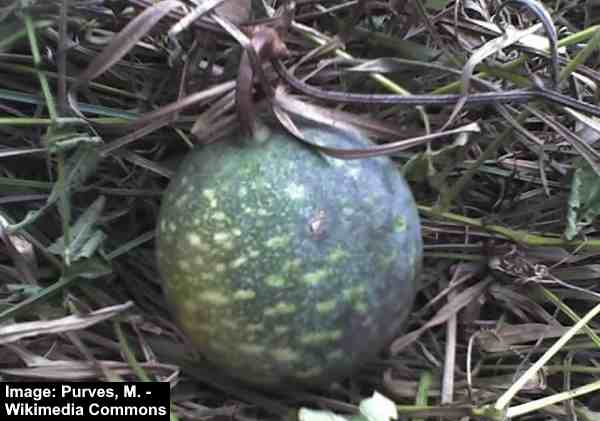
Also called wild calabash, the wild melon gourd produces a rounded green fruit ball shaped like a soccer ball. Resembling small watermelons, the unique bottle gourd fruits are about the size of a baseball—10” (25 cm) in diameter. The yellow-speckled green fruits appear after the fragrant, creamy-white flowers have finished blooming.
Unlike other decorative fruits in the bottle gourd family, the wild melon gourd has a short, woody stem. Although its flesh is edible, it doesn’t taste very pleasant and is rarely consumed. The gourds are typically grown for ornamental and crafting purposes. Their smooth skin and hard shell make them highly versatile ornamental berries.
Sponge Gourd (Luffa aegyptiaca)

Sponge gourd—also called Egyptian cucumber—is a tropical vine producing long, cylindrical fruits. The vining fruits are famous for their fibrous interior, used for loofah sponges. Sponge gourd vines have three-lobed leaves up to 8” (20 cm) wide and large, five-petalled yellow flowers with ruffled petals.
Resembling huge cucumbers, sponge gourds are dried, soaked in water, and peeled. Once dried, the tubular, fibrous interior is cut or sliced to sell as exfoliating bath sponges. Additionally, the large ground seeds can be used to extract oil. Its attractive yellow flowers also give the gourd vine ornamental value in garden landscapes.
Angled Luffa (Luffa acutangula)
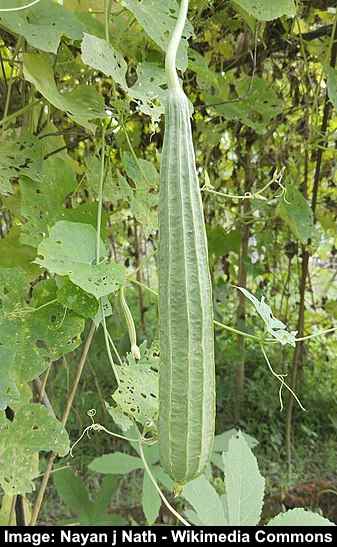
Like the sponge gourd, the angled luffa is an elongated zucchini-like fruit used for making bath sponges. Angled luffas grow up to 16” (40 cm) long and measure 4” (10 cm) in diameter. As the fruit matures, its flesh becomes a pale tan fibrous interior under the ridged green skin. This decorative vine also has attractive bright yellow flowers.
Also called the ridged gourds or Chinese okra, mature angled luffas are cylindrical fibrous fruits. After being dried and processed, the tubular dried fruits are sliced into bath sponges for exfoliating skin. In some countries, the fiber is used to make hats.
Snake Gourd (Trichosanthes cucumerina)

The snake gourd is a highly unusual cylindrical gourd fruit that can grow 6.5 ft. (2 m) long. The strikingly long, curved fruits resemble serpents dangling from vines. The gourds emerge white, turn green, and are orange-red when mature. Snake gourd vines bloom with spectacular white lace-like flowers, adding to the vine’s attractiveness.
The twisted, elongated green fruit has a soft skin and mucilaginous flesh. It’s a popular ingredient in Asian cuisine when harvested before it reaches maturity. When mature, the pulp is reddish-orange, sometimes turning the skin the same color. In warmer climates, the vining plant is used in gardening and landscaping for its ornamental value.
Apple Gourd / Indian Squash (Praecitrullus fistulosus)
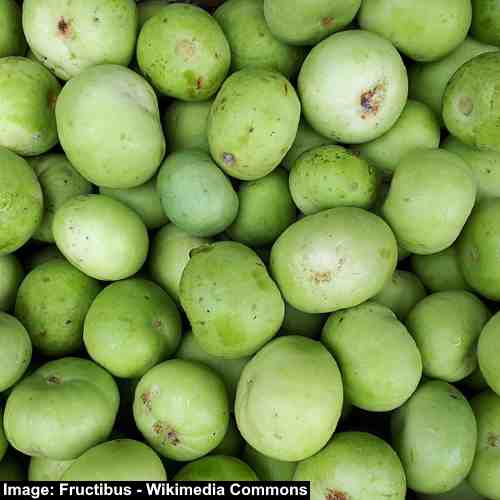
The apple gourd is a small, round gourd resembling a miniature apple. Also called Indian baby pumpkin, the cucurbit fruit has a smooth, pale green to yellowish-green skin. The irregularly shaped round fruits grow on prickly stems, like zucchini. The small apple gourds measure 2” to 3” (5 – 8 cm) in diameter.
Also called tinda, squash-like apple gourds are native to India and are popular in Asian cooking. The apple-like fruits have a smooth texture and a subtle, mild taste. This allows it to take on the flavors of other spices and ingredients. The rigorous annual vine starts producing fruits 70 days after planting.
Turk’s Turban (Cucurbita maxima)

Turk’s turban is a colorful type of gourd with an unusual appearance. The winter squash resembles a red, green, and yellow turban with a cap. The cap has pronounced ridges similar to buttercup squash. The strange-looking gourds can measure up to 1.3 ft. (0.4 m) in diameter and weigh 5.5 lbs. (2.5 kg).
Some smaller varieties of Turk’s turban are bi-colored with white and red parts.
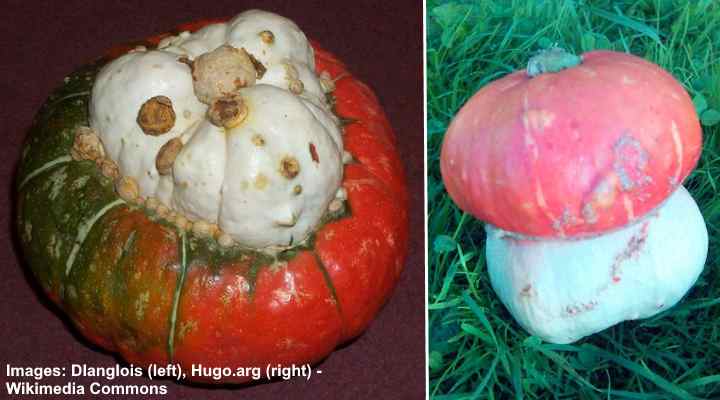
More examples of turban squash
Turk’s turban is an edible gourd with ornamental qualities. As a vegetable, the cucurbit has a slightly nutty, sweet taste and a watery texture. However, it’s not as tasty as other varieties of Cucurbita maxima, like buttercup squash, Hubbard squash, or Boston marrow.
Wax Gourd (Benincasa hispida)

The wax gourd is a type of edible winter squash with a spherical or oblong shape. It grows 2 ft. (0.6 m) long and 0.8 ft. (0.25 m) wide. The large gourd melons grow on thick vines with rough, lobed leaves. Like most gourd plants, the vine blooms with yellowish, funnel-shaped flowers.
Wax gourd fruits have thick flesh with a sweet, crisp texture. The fruits are a staple ingredient in many culinary dishes in China, Vietnam, the Philippines, and India.
Cucuzza Squash
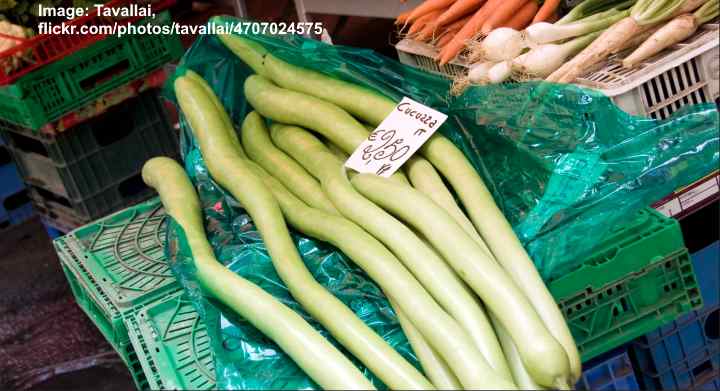
Cucuzza squash is a type of Italian summer squash that can grow up to 2 ft. (0.6 m) long. The slender, elongated gourd has light green skin and a slightly waxy texture. The flesh is tender and mild in flavor. The vine also produces small white star-shaped flowers with five ruffled petals.
Cucuzza gourd plants are easy to grow on trellises that help support the long, snake-like gourds. The edible squash plant is used in culinary dishes like typical squash—grilled, sautéed, fried, roasted, or baked.
Its ornamental value in summer gardens comes from its eye-catching cylindrical snake-like fruits that dangle from vigorous vines.
Buffalo Gourd (Cucurbita foetidissima)
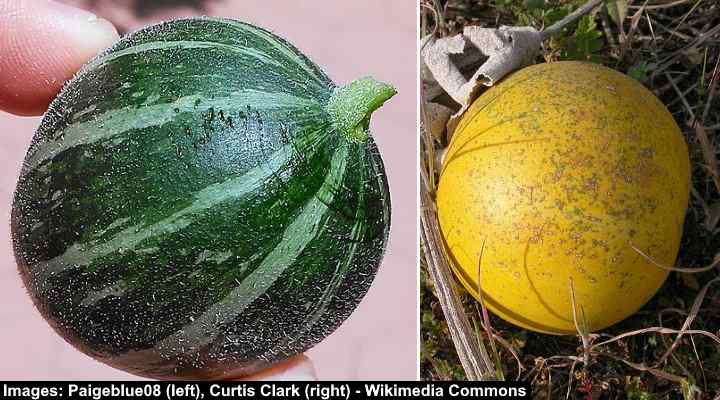
Immature and mature buffalo gourd
Buffalo gourd is a sturdy, drought-tolerant vining plant that produces round fruits up to 4” (10 cm) in diameter. The small, round, dark green fruits have lighter bands running from top to bottom. When mature, buffalo gourds become vibrant yellow. The vining plant also produces yellow funnel-shaped flowers.
Native to the Central and Southwestern United States, the edible round gourd is only tasty when young. The thick flesh is bitter at maturity when the gourd is only used for ornamental purposes. This perennial vine has a large underground tuber that helps it thrive in drought-prone environments.
The seeds of the buffalo gourd can be roasted and eaten as a snack or ground into flour for baking.
Ivy Gourd (Coccinia grandis)
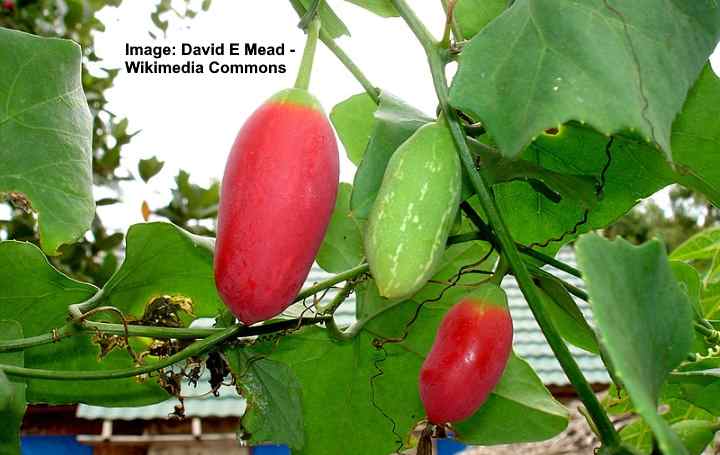
Mature (red) and immature (green) ivy gourds
The ivy gourd is a perennial climbing vine with small green fruits that look like stumpy cucumbers. The oval fruits measure up to 2.4” (6 cm) long and grow on vigorous, sometimes invasive, vines 65 ft. (20 m) in length. The sprawling vine also produces brilliant white funnel flowers in the shape of a star.
Also called scarlet gourd, the young fruits are firm and green with a crunchy, mildly sweet taste. As they mature, they turn bright red or orange and become softer and sweeter. Ivy gourd is commonly used in various cuisines. The young fruits can be stir-fried, pickled, or added to soups and curries.
It’s good to note that an ivy gourd has an extensive tuberous root system that spreads aggressively. It can quickly smother vegetation and scramble over fences and other structures.
Cushaw Squash / Silver-Seed Gourd (Cucurbita argyrosperma)

Known as the silver-seed gourd, the cushaw squash is an edible variety often used as a vegetable. This gourd is easily recognized by its large, teardrop-shaped fruit, which features a distinctive mottled pattern of green and silvery-white on its skin. The large fruit can weigh as much as 20 lbs. (9 kg), growing on vines that extend 10 to 15 feet (about 3 to 4.5 meters) in length.
The cushaw squash belongs to the winter squash family. It’s known for its sweet, yellow-orange flesh, which has a mild and pleasant flavor. This versatile squash is perfect for baking, grilling, or frying, and it can also be used as a substitute for pumpkin in various recipes.
There are several other notable varieties of cushaw squash. The ‘Tricolor Cushaw’ is marked by its vibrant orange and green skin. The ‘White Cushaw’ is known for its creamy white skin and contrasting yellow flesh. Additionally, the ‘Green Striped Cushaw’ features distinctive whitish lateral stripes, adding to its visual appeal.”
Crown of Thorns Gourd (Echinocystis lobata)
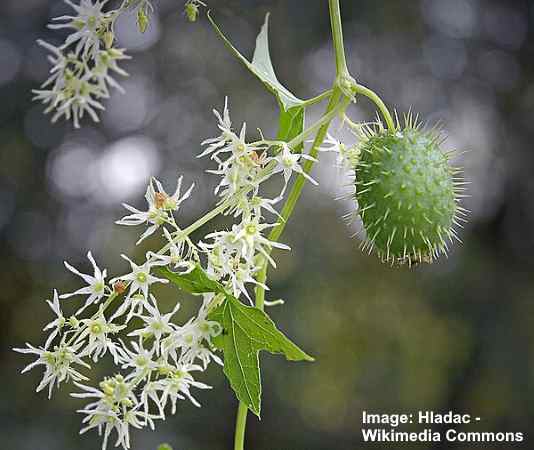
Also called prickly cucumber, the Crown of Thorns gourd produces small, spiny green fruit and creamy-white flowers. The spiky, thorny gourds measure 2” (5 cm) long and only contain inedible seeds, which is why they are also called bur cucumbers. The annual vine produces stems up to 26 ft. (8 m) long.
Butternut Squash (Cucurbita moschata)
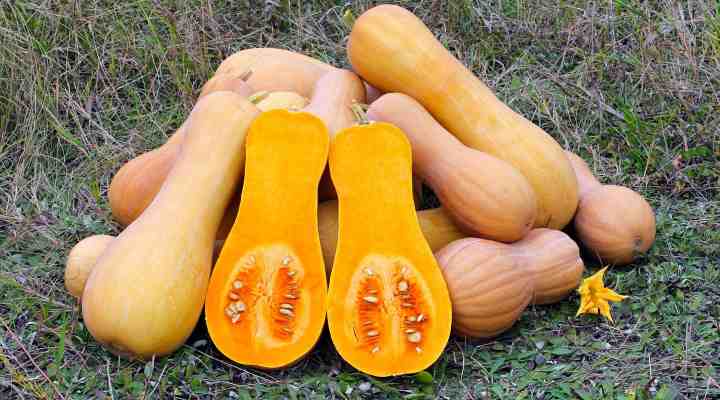
Butternut squash is a popular type of winter gourd. Its distinctive bell shape, smooth, tan skin, and vibrant orange flesh make it easily identifiable. The fast-growing vines produce fruit weighing up to 5 lbs. (2.3 kg), ready for fall harvesting. The vining plant also has velvety-hairy, deeply-lobed leaves and orange-yellow flowers.
Butternut squash becomes sweeter the more it matures. It’s a prized fruit-vegetable with a sweet, nutty flavor and creamy orange flesh. The versatile fruit is ideal for roasting, mashing, or making hearty soups and stews. The squash also contains vitamins A and C, beta-carotene, and dietary fiber.
Some of the more exotic butternut squash varieties have a long gooseneck (‘Neck Pumpkin’), a round shape (‘Texas Indian Moschata’), or a flattened shape (‘Long Island Cheese’).
Acorn Squash (Cucurbita pepo var. turbinata)
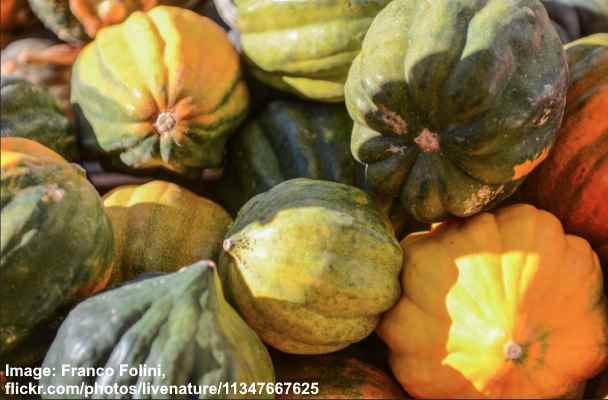
Acorn squash is a distinctive, dark green or yellow round gourd with longitudinal ridges. The small winter squash has an acorn-like shape, measuring 4” to 7” (10 – 18 cm) long and weighing 2 lbs. (0.9 kg). The fruiting vine grows up to 2 ft. (0.6 m) tall and 4 ft. (1.2 m) long, producing edible yellow flowers in the spring.
As a delicious edible gourd, acorn squash has a sweet and nutty flavor. It is typically used in baking and roasting. However, it’s a great all-round fruit with edible skin and seeds. Curing for at least ten days after harvesting ensures it keeps its sweet taste for longer.
Winged Gourd (Cucurbita pepo)
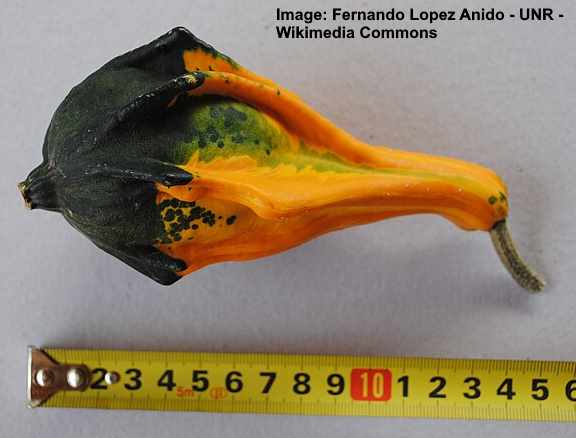
Winged gourd is a general term for small ornamental gourds with a bulging pear shape and distinctive ridges on their exterior. The small gourds have vibrant yellow and dark green colors, giving them tremendous ornamental appeal. Also called ‘Autumn Wings,’ the decorative fruit usually measures 4” to 6” (10 – 15 cm) long.
Depending on the variety, winged gourds can have ridged, lime green, warty bases with a creamy-yellow elongated top. Other varieties may be entirely dark green, giving the ornamental gourd a striking appearance. The fruits are usually in floral arrangements or displayed as a unique and eye-catching centerpiece.
Tennessee Spinning Gourd (Cucurbita pepo)

The Tennessee spinning gourd is a small, round gourd with a slightly elongated neck. Like other types of gourds in the genus Cucurbita, this variety has dark green skin and yellowish or whitish-pale green stripes. The bulbous gourd only measures 3” to 4” (7 – 10 cm) in diameter.
The small bottle-shaped gourds are typically used for their ornamental value. For example, in the 1800s, the small green striped gourds were used as spinning tops—hence the name, Tennessee spinning gourd. Now, the gourds are popular for craftwork and are painted or carved to create personalized art pieces.
Warty Gourds

Warty gourds refer to a group of gourds with bumpy, textured skin resembling exterior growths. Warty bumps can affect all types of gourds and are harmless. The bumps can be of various colors, ranging from blue to green, yellow, and deep orange. They add to the visual appeal of the ornamental gourds.
Warty gourds are primarily used for decorative purposes. Their unique texture and colors add visual interest to fall displays.
Can you eat decorative, warty gourds? While most warty gourds are edible, they are difficult to prepare for consumption. Some also taste bitter and unpalatable. Also, they don’t contain much edible substance and are hard to cook. Therefore, it’s best to choose types of squashes to incorporate the tasty fall vegetables in your diet.
Bitter Gourd (Momordica charantia)
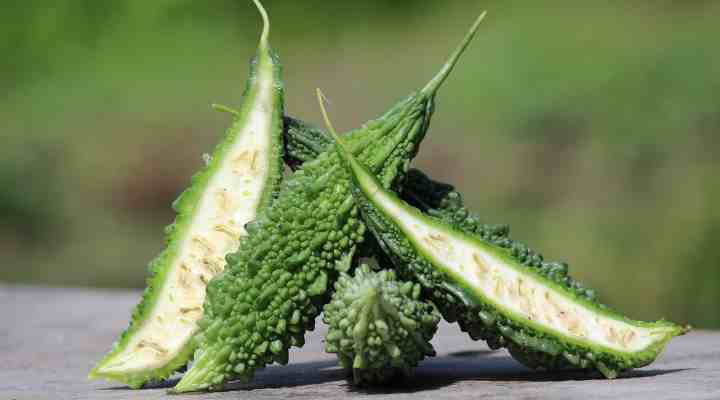
Bitter gourd is a unique green, oblong gourd with bumpy, green skin and a distinctive bitter taste. The unusual fruits measure 4” to 8” (10 – 20 cm) long and have ridges along their length. The bitter gourd plant produces yellow flowers that eventually give way to the green fruits.
The bitter gourd is not commonly eaten in Western cuisine due to its intense bitterness. However, it’s a popular ingredient in many Asian dishes. It is often cooked with other ingredients to help balance out its strong flavor.
In addition to its culinary uses, bitter gourd is grown for its ornamental value. The unique shape and texture of the fruit make it an interesting addition to gardens and landscapes. It is often grown on trellises or other supports to allow the vines to climb and create a striking display.
Pointed Gourd (Trichosanthes dioica)

The pointed gourd—also called parwal or potol—is a small green oval fruit with greenish-white longitudinal stripes and tapered ends. The small edible gourds measure 2” to 6” (5 – 15 cm) long. The tropical vine blooms with showy tubular flowers that flare at the top with five petals in a star shape and hairy, frilly edges.
The pointed gourd vine grows 16 to 20 ft. (5 – 6 m) long, and its thick stems climb via simple tendrils. It’s a perennial vine that thrives in warm, humid climates and spreads through tuberous roots.
Pointed gourds are a popular vegetable in Indian cuisine. They have a mild, slightly bitter taste that pairs well with spices and other vegetables. In addition to chopping the gourds in curries, stir-fries, and stews, the young leaves are edible.
How to Grow Gourds
Growing all types of gourds from seed is straightforward. The annual vining plants thrive in USDA zones 3 to 11, and you can find edible and ornamental gourds suitable for all climates.
Here are some top tips on growing gourds from seed:
Prepare the soil: Turn the soil over and work in 2” to 3” (5 – 7.5 cm) organic material like compost, leaves, or rotted manure. Till the soil to a depth of 10” inches (25 cm).
Create soil beds: Form rows of soil beds 4” to 6” (10 – 15 cm) high and 3 ft. (0.9 m) apart.
Planting: Plant gourd seeds in spring after the last frost, ensuring the soil has warmed sufficiently. Create holes 1” (2.5 cm) deep and 4 ft. (1.2 m) apart.
Plant seeds: Put two seeds in each hole and cover thinly with soil, ensuring they are adequately covered for germination.
Watering: Water the seeds immediately after planting to provide essential moisture for germination.
Thin seedlings: Thin them to three plants per hill once germinated, and the seedlings are 3” to 4” (7.5 – 10 cm) tall.
Continue watering throughout the season to prevent the ground from drying out. You can train gourds to scramble over a trellis or let them sprawl on the ground.
Harvesting and Curing Different Types of Gourds
Different gourds may have specific curing requirements based on their size, thickness, and intended use. But here are a few general guidelines on when to harvest gourds and how to cure them.
Edible gourds: Wait until the rind is hard with a mature color, the stems are woody brown, and tapping the fruit produces a hollow sound. To remove the giant “berries,” cut them from the vines with a sharp knife, leaving 3” (7.5 cm) of stem. Avoid the temptation to pull or twist them. Always carry the squash, but never by the stem. To cure the squash and prepare it for eating, leave it in a sunny spot for ten days.
Ornamental gourds: Follow the same instructions as for harvesting edible gourds. It’s vital to wait until the stems turn brown and the tendrils are dry. To harvest luffas, leave them on the vine to dry, and the green fruits have turned brown at each end. You’ll know they’re ready when the seeds rattle inside when shaken. Ensure the inner fiber is dry and tan by peeling off the outer skin.
Hardshell gourds: Let hardshell gourds, such as bottle gourds, dry out in the garden. The skin will naturally fade and discolor, even showing signs of mold. Nevertheless, if the shell does not rot, it will continue to dry internally.
Depending on the shell’s thickness, the drying and curing process takes three to six months. It’s important to wait until the gourd is completely dry before working with it on craft projects.
Uses for Dried Gourds
Non-edible bottle gourds have diverse shapes, sizes, rinds, and colors. Their unique form makes them perfect for creating visually appealing arrangements and craftwork. For example, bulbous bottle gourds are ideal for creating purple martin birdhouses.
Here are some other ways to use dried gourds:
Crafting and carving: The hard shell-like skin that forms on dried gourds is ideal for crafting projects. You can carve and paint them to create bowls, spoons, or containers.
Gourd birdhouses: Dried hollowed gourds are perfect for sustainable and eco-friendly birdhouses. You can hang them from trees or poles to provide shelter for birds, increasing biodiversity in your garden landscape.
Candle holders: Hollowing out gourds with flat bases is a novel way to create candle holders.
Painted gourd art: Gourds with smooth skins provide a canvas for creating works of art. Dipper gourds, gooseneck gourds, and many bottle gourds look stunning when painted with detailed designs and vibrant colors.
Musicians also appreciate dried gourds for their use in creating unique instruments such as maracas, drums, or stringed instruments, taking advantage of their natural resonance.
Gourds — FAQs
Are gourds fruits or vegetables?
Botanically speaking, gourds are a type of fruit used like vegetables. The thick-fleshed fruits develop from the ovary of a flower and contain seeds. This also means that all gourd varieties—from pumpkin to squash and cucumbers—are technically tough-skinned berries or pepos.
How long does it take for gourds to grow?
Gourds are fast-growing annual vines that produce bumper crops in a single season. Depending on the variety, it takes between 70 and 120 days from planting until the first fruit is mature and ready for harvesting. Of course, environmental conditions can also affect how long it takes gourds to grow.
Can you grow gourds in containers or pots?
Gourds are ideal vining plants for growing in pots or containers. You will need a large container with proper drainage and filled with well-draining soil. Ensure the plant gets sufficient sunlight. Regular watering and fertilization are essential for successful gourd growing. Vining varieties may need support or a trellis.
How do you choose a ripe gourd?
There are three ways to tell if a pumpkin or butternut squash is ripe—the rind, sound, and skin texture. A ripe pumpkin will have a hard skin. Try piercing the skin with your fingernail. If it doesn’t puncture but just dents, it’s ready to be picked. Next, tap the pumpkin—it should make a distinct hollow sound. Finally, check the stem. A ripe squash will have a brown, hard, almost woody stem.
Why are gourds bumpy?
Bumps or warts on gourds are often a result of genetic factors or environmental conditions during growth. Some gourd varieties naturally develop bumps, warts, or unique textures on their skin. Some gourds have a water imbalance due to weather issues. Also, cucumber beetles can feed on the fruit before it fully develops, leading to hardened skin and bumpy surfaces.
It’s good to remember that bumps on gourds contribute to the visual appeal of ornamental gourds and do not necessarily indicate a quality issue.
Related articles:
